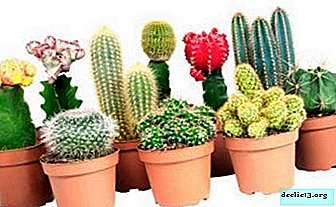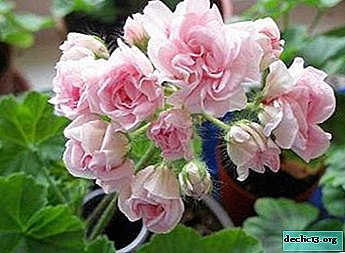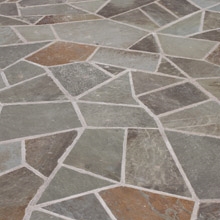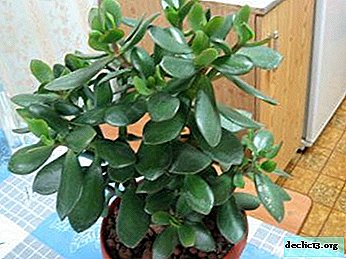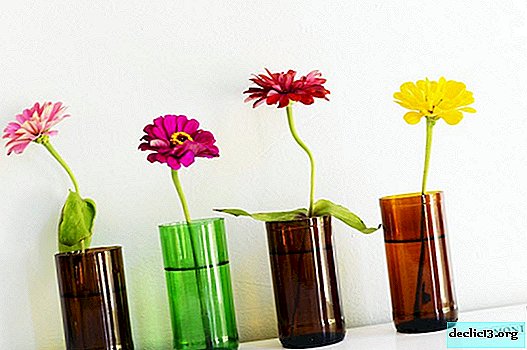What is a vanilla orchid and how to care for it? Flower photo
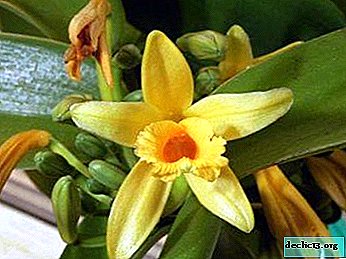
The aroma of vanilla for many is something from a distant childhood: vanilla rolls, delicious vanilla ice cream and mother's perfume. But few people suspect that the spice is obtained from the seeds ... orchids! The plant grows in Central America, it is bred in many countries as an expensive spice. Moreover - a vanilla orchid can be grown on your window!
Interesting: the fact that vanilla smell really affects our nervous system, relaxing and calming, has been proven by scientists.
Description of Vanilla Flower
The genus of Vanilla orchids has more than 100 varieties, but the same vanilla is obtained from only three. The most famous Vanilla planifolia (vanilla squamous). It is a common species that grows in humid tropics, such as the Antilles, Mexico and Panama. The Latin generic name is derived from the Spanish word vainilla - "pod". Vanilla fruits really have that shape.
Vanilla orchid is a succulent vine, growing partly on the ground, and partly as an epiphyte. She begins her life by sprouting and rooting in rotting leaves. In the future, she "creeps" up the trees, using her aerial roots for this. An adult plant can reach a length of up to 30 m in its natural environment. In greenhouses, it rarely exceeds 15 m, at home - even less.
 Creeper orchid creeper, it is distinguished by a special fabric structure that actively stores and preserves water. The stem of a vanilla orchid is very thin and long; leaves are located along its entire length. They are thick, leathery, up to 18 cm long, have an elliptical shape, evergreen. From each leaf node, air roots grow that hold the vine - powerful, gray-green in color.
Creeper orchid creeper, it is distinguished by a special fabric structure that actively stores and preserves water. The stem of a vanilla orchid is very thin and long; leaves are located along its entire length. They are thick, leathery, up to 18 cm long, have an elliptical shape, evergreen. From each leaf node, air roots grow that hold the vine - powerful, gray-green in color.
The flowers of flat-leaf vanilla, compared with other varieties of orchids, are not very effective: they are inconspicuous, yellow-green, not very large (up to 10 cm in diameter). Petals of flowers are as if covered with wax. Inflorescences are collected in brushes of 5-7 pieces each, they appear in the axils of the leaves, most often in the upper part of the plant, at the ends of shoots - very rarely. Flowers, like orchid fruits, have a persistent, pleasant and easily recognizable vanilla flavor.
The flowering period of the vanilla orchid is very short: the bud lives only 8 hours. During this time, it should completely bloom and pollinate. The latter is not easy: only the bees of the genus Melipona, living in Mexico, pollinate vanilla flowers. Occasionally, hummingbirds also perform this function. Unsurprisingly, vanilla, harvested from fruits, not plant flowers, is so highly regarded.
Reference! By growing vanilla orchids, you can do business: 4 grams of the pods of this plant in Europe are sold for a cost of 4 to 8 euros, that is, one kilogram of vanilla can cost up to 2 thousand euros!However, the vanilla orchid blooms for up to a month. This is because the buds are not opened all at once, but in turn. If pollination was successful, pods are tied on the plant - also in groups of 6-10 pieces. Pods, like flowers, are yellow-green, with a persistent smell. They are long (up to 25 cm). Until the fruit fully ripens, it takes up to 7 months.
Breeding history
To date vanilla orchid is grown for sale in Zanzibar, Oceania, Indonesia, the Seychelles, Madagascar. Such cultivation became possible only after the secret of plant pollination was revealed. Europeans did this in the 19th century, they also spread fragrant spice throughout the countries.
Vanilla remains an agricultural crop (the only one!) Hand-pollinated today. Child labor is often used for this - it is possible to pollinate them with up to a thousand buds a day ... By the way, the method of manual pollination of vanilla was also discovered by a child - 12-year-old Edmond Albius.
But the discoverers of the plant were still not the Europeans, but the Aztecs. Not knowing the secret of pollination, they collected wild vanilla and used it as a medicine and seasoning. She laid in their traditional drink to chock - the ancestor of modern hot chocolate with spices. In those days, this spice was really worth its weight in gold: the Aztecs even collected taxes with vanilla pods!
Vanilla planifolia and other species
Vanilla planifolia is considered a unique plant. Unlike the other two species also cultivated for sale (Vanilla pompona and Vanilla tahitensis), it produces the best varieties of vanilla and the longest pods. Vanilla orchid differs from other representatives of the orchid family in that it grows in the form of a vine and can grow incredibly long. She also has a similarity: like the other varieties of orchids, a plane-leaf orchid has many aerial roots and characteristic dark green and dense leaves.
Among other known varieties, Tahitian vanilla stands outgrowing in Tahiti, islands of French Polynesia and Niyue. West Indian vanilla grows in the Caribbean and in South America. These plants are actively used in perfumes.
Photo
See how the vanilla orchid looks in the photo.





Orchid bloom
Flowering vanilla orchids - this is the issue in which experienced gardeners can not come together. Under natural conditions, the plant blooms in the third year. At home, an orchid theoretically can also bloom, but in practice it is difficult to wait.
There are lucky ones whose flower still blossoms. Two conditions are necessary for this:
- Height not less than 10 meters.
- Constant heat (not lower than +25 ºС in the summer and +20 ºС in the winter).
There is a paradox associated with the second condition: there are more chances to bloom on the southern window, but its leaves burn out and it takes on an untidy look. And on the east or north window, the leaves will remain in order, but flowering can not wait.
This orchid species does not have a pronounced dormant period, so it will not work to stimulate flowering in this way.
Important! It is impossible to get the fruits from a vanilla orchid at home.If the vanilla orchid blossoms on the windowsill, then it will reward the owner for all efforts. A lot of flowers - yellow, green or even white - are formed a lot, flowering lasts up to three weeks. At this time, a delicate pleasant aroma comes from the plant, allowing you to feel yourself not at home, but on distant tropical islands ...
A blooming orchid does not require any special care. After flowering, you need to cut the peduncles.
We look at the video what the Vanilla orchid in bloom looks like:
Care instructions
If you want to settle a piece of the tropics in your house, you will have to try. Special conditions are needed for the smooth growth of a vanilla orchidas close as possible to the natural habitat. That is, a tropical forest, where it is warm, damp and there is no lack of lighting.
Seat selection
As with other orchids, you need to choose a warm, cozy place with diffused light. Drafts are contraindicated, direct sunlight - too. Best south-west or east side. To ensure that the orchid does not hurt, you need to provide excellent air circulation.
Soil and pot
 In the natural environment, vanilla is a vinethat grows by clinging to tree trunks. She should be put at home in a hanging pot and provide a place for her to wander. You may prefer a regular flower pot, but in this case you need support in which the orchid will launch its aerial roots. A mesh is best.
In the natural environment, vanilla is a vinethat grows by clinging to tree trunks. She should be put at home in a hanging pot and provide a place for her to wander. You may prefer a regular flower pot, but in this case you need support in which the orchid will launch its aerial roots. A mesh is best.
The soil requires breathable, rich in organic matter. It is somewhat different from usual for epiphytes. You can take ordinary garden soil, add pine bark, fern roots and a little sphagnum there (2: 1 mixture). Charcoal is put down. Try the resulting mixture: it should be light, loose.
Temperature
Ideal temperature - from +25 to + 30 ° С all the time (both in winter and in summer). If there are no such conditions, try not to drop the temperature below +18 ° С. Vanilla orchid will be able to adapt to daytime temperatures 4 ° C below the permissible, but care must be taken to ensure that there are no sharp temperature drops in the light and dark.
Humidity
Like all tropical plants, vanilla loves moisture. 80-90% humidity - these are ideal conditions. To achieve this mark you need to constantly water and spray (soft, warm water). You can also make showers for your orchid under warm running water that mimics tropical rainfall. The main thing is not to damage the delicate leaves. But give up the procedure if hard water flows from your faucet.
Lighting
You need to achieve bright and at the same time scattered light throughout the day. From direct sunlight, the leaves will begin to fade. It is possible to move the orchid to the sunny side so that it blooms faster, but this can only be done in the third year of life and only if the plant is strong.
Watering
Follow the rule: the higher the temperature in the room, the more often watering. Drying of the substrate is not allowed! Like other types of orchids, vanilla can be watered by immersing the pot in water.
Attention! In summer, watering should be more plentiful, in winter reduced.Water the orchid with lime-free mineral water. If you live in an ecologically clean region, you can replace it with warm rainwater.
Top dressing
You can fertilize year-round, once every 3 weeks. Only special fertilizer for orchids is used - the usual for indoor plants will be too concentrated. Concentration - ½ of that indicated on the package. An overdose will negatively affect the roots, they can blacken, slug and fall off.
Transfer
The plant is transplanted every 2-3 yearsotherwise the root system will grow and slow down growth. This is done in the spring. Try to prevent root damage. If this does happen, the roots need to be treated with charcoal to prevent infection.
A vanilla orchid should be pruned regularly - so it will rejuvenate, become more magnificent, releasing side shoots. Trimming is possible at any distance, removed tops are used for landing.
Breeding
 Orchid propagated by cuttings (at least 30 cm high). Faster are those that already have aerial roots. For guaranteed success, you can treat them with an amplifier for the development of the root system (heteroauxin). The shank is planted in a pot with prepared soil, fixed on a support. The soil is wetted, after which the pot with the handle is closed with a plastic bag and left in a warm, shady place. You can remove the package in a month. If new sprouts appeared, then rooting was successful.
Orchid propagated by cuttings (at least 30 cm high). Faster are those that already have aerial roots. For guaranteed success, you can treat them with an amplifier for the development of the root system (heteroauxin). The shank is planted in a pot with prepared soil, fixed on a support. The soil is wetted, after which the pot with the handle is closed with a plastic bag and left in a warm, shady place. You can remove the package in a month. If new sprouts appeared, then rooting was successful.
You can grow a vanilla orchid from seeds. But only from those that you bought in a specialty store. The vanilla seeds sold for cooking have been heat treated and are not viable.
Watch a video on how to properly root orchid cuttings:
Diseases and pests, prevention of problems
Vanilla is notable for the fact that there are no pests on it.. She may be ill due to improper care. When the gulf develops root or stem rot, which destroys the plant. Watering in this case is reduced, and the plant is immediately replanted. Dry leaves indicate a lack of watering, moisture or improperly selected soil. Try to water and spray more often, if this does not help, transplant.
So that the plant grows well and does not cause problems, you must initially choose a healthy specimen. Look at the leaves: they should be uniformly green, without spots and splashes. If you buy a blooming orchid - take the one with flowers still in buds.
With quality and competent care, a vanilla orchid will grow by half a meter in six months. This perennial plant will decorate the house with its lush greenery. Well, if you manage to achieve flowering, you can be proud of yourself and enjoy the delicate and delicate aroma of vanilla.
Useful video
Next, a visual video about the vanilla orchid:


